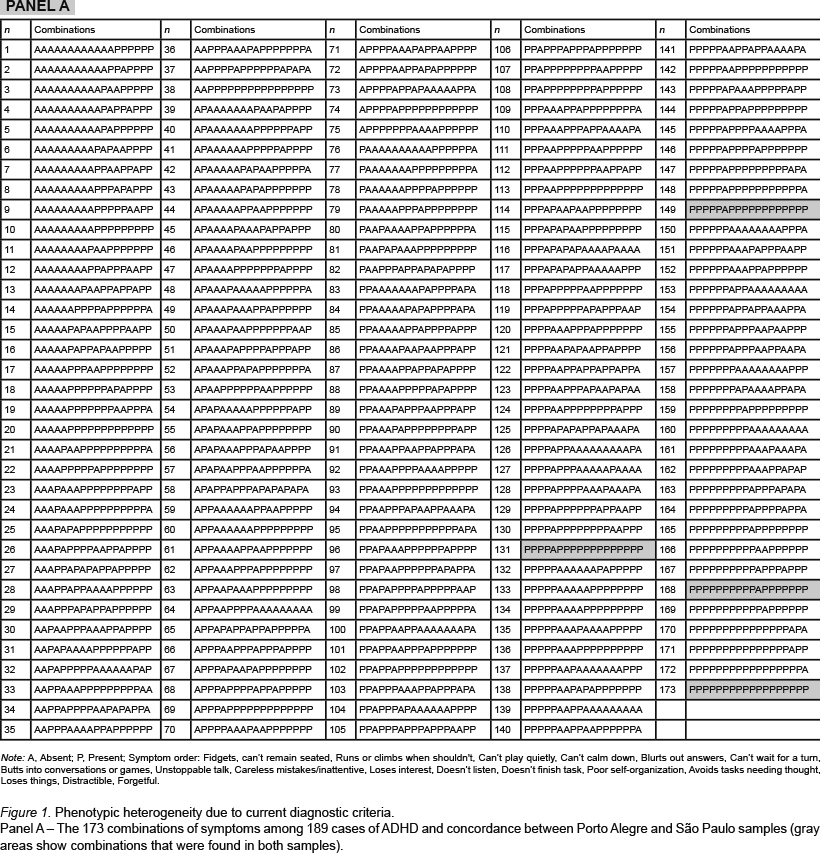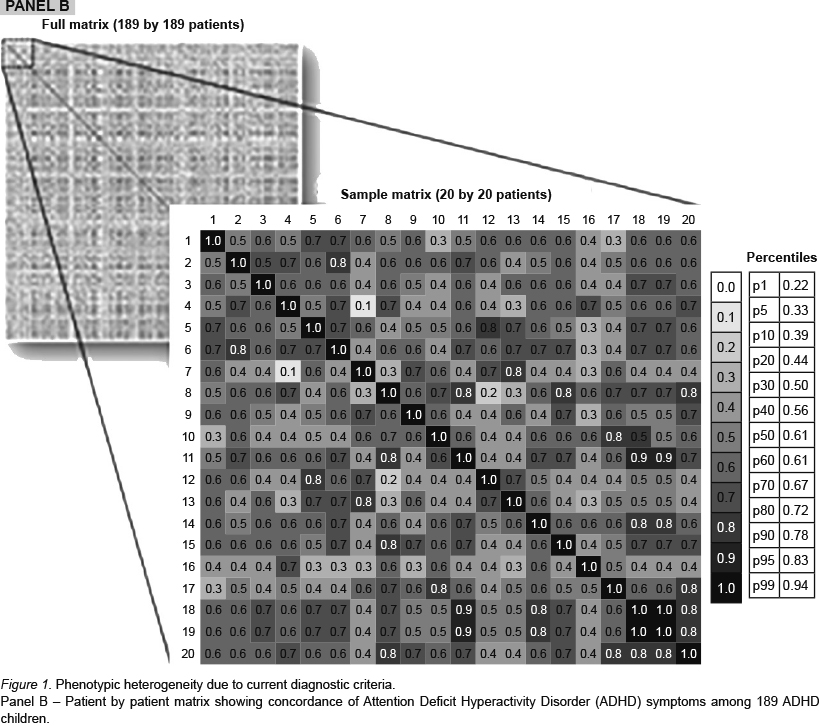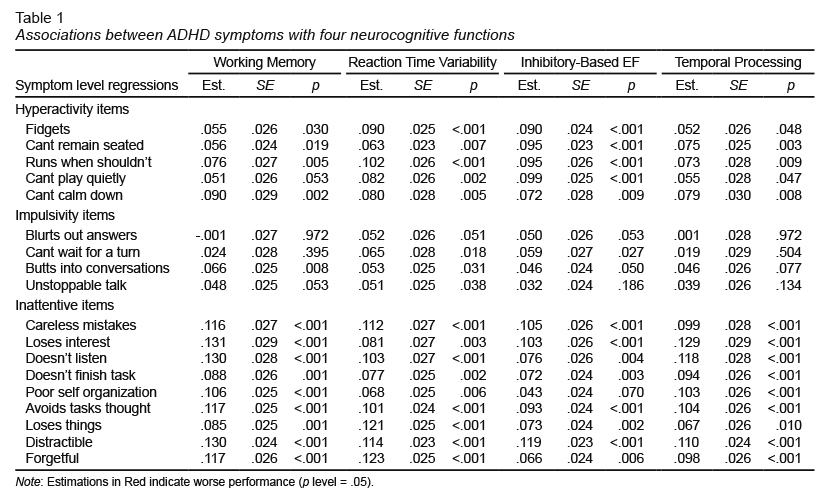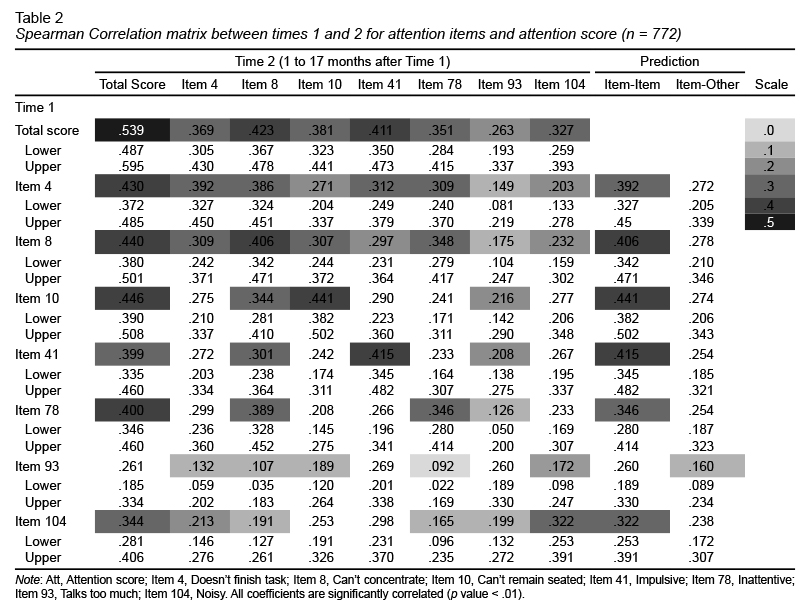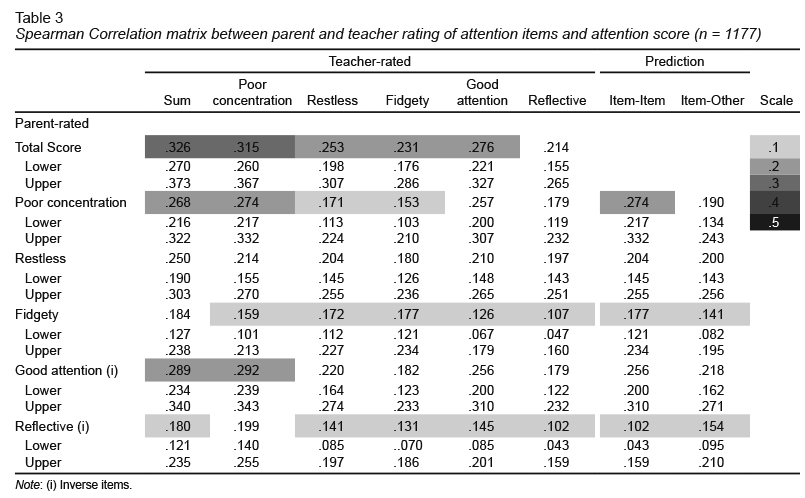Introduction
In May 2013, the American Psychiatric Association published the fifth edition of the Diagnostic and Statistical Manual of Mental Disorders (DSM-5). The DSM-5 was initially planned to integrate findings from neuroscience to the diagnostic criteria (Hyman, 2007). Nevertheless, the DSM-5 Task Force soon realized the complexities and limitations associated with including biomarkers (e.g., genetic, imaging, blood) into the diagnostic system and the new version of the manual conserved its descriptive-phenomenological nature. This decision was mostly driven by the observation that evidence suggesting a potential role for biological markers of mental disorders were restricted to group level differences, and none of them had sufficient validity at the individual level to demonstrate clinical utility (Kapur, Phillips, & Insel, 2012). Among a variety of reasons that may be responsible for this lack of translation, “heterogeneity” in the way we classify psychiatric disorders is considered essential (Kapur et al., 2012; Sonuga-Barke, 2013; 2010).
Psychiatric disorders are defined in terms of polythetic operationalized diagnostic criteria, i.e., a combination of a certain number of symptoms (a collection of behaviors, emotions, thoughts, and sensory phenomena) that needs to be perceived by the individual and/or by others as causing significant impairment. They are called polythetic because each diagnosis shares a number of characteristics which occur commonly in members of a group but none of which is essential for group membership. The inclusion of polythetic operationalized diagnostic criteria to our current classificatory manuals dates back to the publication of the Feighner criteria (McLaughlin & Nolen-Hoeksema, 2011; Nolen-Hoeksema & Watkins, 2011), which formed the basis for the development of the Research Diagnostic Criteria, which in turn were central to the development of the DSM-III. Since then, all subsequent versions of the DSM adopted the polythetic system for a variety of diagnoses, allowing for phenotypic variation in the symptom manifestations of a disorder as a way to provide more diagnostic flexibility or, in other words, increase “coverage” (Merport & Recklitis, 2012). In modern psychometric words, the polythetic system is built under the idea that endorsements of diagnostic criteria are only fallible markers of underlying latent constructs that explain symptomatic aggregation.
The adoption of polythetic systems has important implications for both the validity and the reliability of mental disorders. Due to its inclusive nature, polythetic systems introduce a great deal of variability in the clinical description of psychiatric syndromes. This great amount of variability may relate to both problems in the validity due to “true heterogeneity” at several levels, and reliability, that is intrinsically related to “measurement error” of a given diagnosis.
With respect to validity, it is important to bear in mind that psychiatric disorders are likely to be fuzzy “kinds of things” like “species”, populations with central paradigmatic and more marginal members. Therefore, heterogeneity in any type of classification is to be expected. Different clinical presentations can be a result of true heterogeneity in at least three levels: the etiological level, the pathophysiological level, and the phenomenological level (Marco et al., 2009; McLoughlin et al., 2009). The etiological level refers to how a given clinical condition can be caused by many different combinations of sufficient sets of etiological factors. The pathophysiological level refers to how a given clinical condition can be a result of distinct pathophysiological processes. The phenomenological level refers to how a given unique clinical condition may be described differently by different subjects. A schematic representation of the various levels of heterogeneity is depicted in Supplementary Figure 1 at https://www.ufrgs.br/prodah/site/wp-content/uploads/2018/11/Supplementary-Figures-SaludMental.pdf.
With respect to reliability, diagnostic criteria are fallible since endorsers are imperfect observers and reporters of symptoms. Variability may be introduced by a variety of factors such as poor clinicians’ abilities, poor wording, lack of transcultural sensitivity, and memory bias, among others, that may indicate “measurement error.” In addition, the assessment of reliability is further complicated by the wax and waning of some psychiatric symptoms and also to different perspectives of observers regarding symptom presence or absence and the degree they affect subjects, which certainly represent much more than measurement error (Penninx et al., 2011).
Few studies have investigated the “trade-offs” of polythetic diagnostic systems for validity and reliability of mental disorders and more specifically for attention deficit hyperactivity disorder (ADHD). First, with respect to validity, specific implications of the operationalization of criteria for heterogeneity are not often discussed. Regarding phenomenological heterogeneity, Olbert, Gala, and Tupler (2014) assessed the number of combinations of symptoms for the diagnoses of several disorders. The authors demonstrated that there are 116 200 possible combinations of symptoms to fulfill DSM-IV ADHD diagnosis. However, few studies evaluated how many of these combinations can be found in real samples. Also, it is not clear how symptom count strategy relates to the underlying latent traits that are thought to underlie symptom endorsement. In addition, few studies investigated pathophysiological heterogeneity at the symptom level. Second, the implications of the polythethic systems to reliability are not well studied either. For example, few studies assess how increasing the number of symptoms for a given trait impacts on test-retest and informant reliability.
Here, we demonstrate the implications of the current operationalization of mental disorders for validity (focusing on heterogeneity) and reliability of ADHD (American Psychiatric Association, 1994). First, we investigated phenomenological heterogeneity assessing the number of possible combinations of symptoms to achieve DSM ADHD diagnosis. Then, we investigated how the symptom count strategy relates to the latent ADHD construct in terms of variation in the general factor. We advance further investigating pathophysiological heterogeneity of ADHD at the symptom level with four well-known neurocognitive validators. Finally, we compared test-retest and informant reliability at the symptom level and at the dimensional level. We performed these four-related analyses using a large community sample of 6-12 year old children from a middle-income country.
Method
Ethic statement
This study was approved by the ethics committee of the University of São Paulo (IORG0004884, project IRB registration number: 1132/08). Written consent was obtained from all parents of participants, and verbal assent was obtained from all children.
Brazilian High-Risk Cohort for psychiatric disorders
This report is part of a large community school-based study – the Brazilian High-Risk Cohort (Salum et al., 2015). A total of 57 schools from two cities (22 in Porto Alegre and 35 in São Paulo) participated in screening and enrollment procedures. From this pool of 9.937 interviews, we selected two subgroups: a random (n = 958) and high-risk stratum (n = 1 524). For subjects in the random-selection stratum, a simple randomization procedure from school directories was used, without replacement of non-available subjects. Selection for the high-risk stratum involved a risk-prioritization procedure based on family history and current psychiatric symptoms. Further information can be found elsewhere (Salum et al., 2015).
Psychiatric diagnosis
The psychiatric diagnosis was established using the Development and Well-Being Assessment (DAWBA) (Goodman, Ford, Richards, Gatward, & Meltzer, 2000). The DAWBA is a structured interview administered by lay interviewers, which also contains the Strength and Difficulties Questionnaire (SDQ) (a 25-item scale enquiring about behavioral and emotional difficulties) and recorded verbatim responses of any reported problems. Verbatim responses and structured questions are carefully evaluated by psychiatrists, which confirm or refute the diagnosis. All questions are closely related to DSM-IV diagnostic criteria and focus on current problems causing significant distress or social impairment. The DAWBA has been translated to several languages, and for the present study the Brazilian Portuguese version (Fleitlich-Bilyk & Goodman, 2004) was administered to the biological parents of all children included in the project. Administrations were performed in accordance with previously reported procedures (Goodman, Ford, Richards, et al., 2000). Nine psychiatrists performed the rating procedures. All were trained and supervised by a senior child psychiatrist. A second child psychiatrist rated a total of 200 interviews and the kappa values between raters for ADHD was high (.72).
Child Behavioral Checklist
The Child Behavior Checklist (CBCL) (Achenbach & Rescorla, 2001) is a widely-used questionnaire assessing children’s behavior and emotional problems. Lay interviewers administered the CBCL Version for School Aged Children (6-18 year old version). Several studies provided evidences of validity and reliability of the instrument across distinct cultures (Rescorla et al., 2012). Parents rate each item based on a three-point scale: (0) Not True, (1) Sometimes/Somewhat True, and (2) Very True/Often True. For this specific study we used the ADHD scale from the DSM-IV scales (Rescorla et al., 2012).
Strengths and Difficulties Questionnaire
The Strength and Difficulties Questionnaire (SDQ) (Goodman, Ford, Simmons, Gatward, & Meltzer, 2000) is a 25-item scale assessing behavioral and emotional difficulties, as well as their resultant impairment and distress. Parents and teachers rate each item based on a three-point scale: (0) Not True, (1) Somewhat True, and (0) Certainly True. The instrument has shown to be reliable and valid across distinct cultures (Anselmi, Fleitlich-Bilyk, Menezes, Araujo, & Rohde, 2010; Woerner et al., 2004). For this specific study we used the Hyperactivity scale (five items).
Neurocognitive tasks
ADHD has been implicated with a variety of neurocognitive deficits such as behavioral inhibition (Hofmann & Smits, 2008), working memory (Hidalgo, Tupler, & Davidson, 2007), intra-subject reaction time variability (Salum et al., 2012; Telzer et al., 2008), and temporal processing (Costello, Compton, Keeler, & Angold, 2003; Ward, 1974). The battery used included the following tests: a) Two-choice Reaction Time (2C-RT) (Hogan, Vargha-Khadem, Kirkham, & Baldeweg, 2005); b) ConflictControl Task (CCT) (Hogan et al., 2005); c) Go/No-Go (GNG) (Bitsakou, Psychogiou, Thompson, & Sonuga-Barke, 2008); d) Digit span: this is a sub-test of WISC-III (Wechsler, 2002); e) Corsi blocks task (Vandierendonck, Kemps, Fastame, & Szmalec, 2004); f) Time Anticipation tasks – 400ms and 2000ms (TA) Toplak & Tannock, 2005); and g) Duration Discrimination (DDT) (Toplak, Rucklidge, Hetherington, John, & Tannock, 2003). Description of each test can be found elsewhere (Salum et al., 2015).
Statistical analysis
Phenomenological heterogeneity
We assessed phenomenological heterogeneity through two approaches. First, using combinatorial analyses. Among the 116 220 possible combinations of symptoms that generate the same diagnosis of ADHD described previously by Olbert et al. (2014), we examined the frequency of these combinations in individuals with ADHD diagnosis in two samples enriched for psychopathology: one from Porto Alegre and the other from São Paulo. Second, we used Confirmatory Factor Analysis. The bifactor model provides a way to simultaneously conceptualize both the communality and specificity of symptoms from separate domains (Brunner, Nagy, & Wilhelm, 2012; Castellanos et al., 2005; Glaser, Thomas, Joyce, Castellanos, & Gerhardt, 2005; Krueger et al., 2002). The model comprises a single general factor accounting for covariation among all symptoms along with separate, specific factors of inattention, hyperactivity, and possibly impulsivity that vary orthogonally with the general factor. The bifactor model better fits with multiple pathway theoretical conceptualizations of the disorder, accounting more clearly for disorder heterogeneity (Nigg, Willcutt, Doyle, & Sonuga-Barke, 2005; Sonuga-Barke, 2005). Previous studies investigating correlated, second-order, and bifactor structures of ADHD symptoms provide evidence in favor of a bifactor model of ADHD (Dumenci, McConaughy, & Achenbach, 2004; Gibbins, Toplak, Flora, Weiss, & Tannock, 2011; Martel, Roberts, Gremillion, Von Eye, & Nigg, 2011; Martel, Von Eye, & Nigg, 2010; Toplak et al., 2009).
A bifactor model with one general factor and three specific factors was fitted to polychoric correlations among the DAWBA items using mean- and variance-adjusted weighted least squares (WLSMV) estimator implemented with Mplus 7.0 (Muthén & Muthén, 2012). The goodness of fit was assessed through the following fit indices: chi-square, CFI (comparative fit index), TLI (Tucker-Lewis Index), and RMSEA (root mean square error of approximation). To demonstrate good fit to the data, previous literature suggests that an estimated model should have an RMSEA of near or below .06, and CFI and TLI near or above .95 (Hu & Bentler, 1999). The bifactor model was the model with the better fit among tested models in the sample (Porto Alegre: FP = 72, X2(117) = 365.291, CFI = .993, TLI = .991, RMSEA = .041 90% CI .036, .046; São Paulo: FP = 72, X2(117) = 330.126, CFI = .995, TLI = .993, RMSEA = .038 90% CI .033, .043). For further details see Ref. (Merport, Bober, Grose, & Recklitis, 2012). This analysis was used to compare the ADHD latent trait with the symptom count strategy. For this purpose, only the general ADHD factor was used for analysis as it was the best reliable proxy of the latent ADHD severity.
Pathophysiological heterogeneity
Confirmatory factor analysis was also used to derive a four-factor model of cognition for ADHD using four of the best neurocognitive deficits associated with the disorder: inhibitory based executive function (Hofmann & Smits, 2008), working memory (Hidalgo et al., 2007), intra-subject reaction time variability (Salum et al., 2012; Telzer et al., 2008), and temporal processing (Costello et al. 2003; Ward, 1974). Fit indexes for the model are as follows: X2 = 752.281 (df = 322, p < .001), RMSEA = .024, 90% CI (.021 - .026), CFI = .994; TLI = .994. The indicators for each domain are as follows: (1) Inhibitory-based executive function: percentage of failed inhibitions in the incongruent trials of the CCT and number of commission errors in the GNG task; (2) Working Memory: the level at which the participant failed to correctly repeat the sequences on two consecutive trials at one level of difficulty in Digit Span and Corsi blocks tasks; (3) Intra-subject variability in Reaction Times: the mean intra-subject variability in the reaction times of the 2C-RT, congruent trials of the CCT and in the go trials of the GNG task; (4) and Temporal Processing: the mean percentage of total hits in the 400ms anticipation task, the mean percentage of too early responses in the 2000ms task and the average of the last five reversal values.
Associations between each ADHD symptom and the four neuropsychological domains were investigated using path analysis in separate models for each ADHD symptom (observed variables) and using the four latent factors representing the four neurocognitive domains.
Reliability analysis
Intra-class correlation coefficients and Spearman correlation coefficients were used for both temporal stability and cross-informant reliability analyses. Temporal stability was measured by the DSM-IV ADHD scale of the CBCL in a sub-sample of 772 subjects with a time-lag of one to 17 months. Cross-informant reliability analysis was performed with the Hyperactivity scale from the SDQ in a sub-sample of 1177 subjects that had both parental and teacher data. For both analyses, we compared the performance of each of the items in predicting itself and all other items.
Results
Validity analysis
Phenomenological heterogeneity - Combinatorial analysis
We examined the frequency of symptomatic combinations in individuals with ADHD diagnosis in two samples enriched for psychopathology. Groups of 1 255 children in Porto Alegre and 1 257 children in São Paulo, as described above, composed the two samples. A total of 118 and 71 children in Porto Alegre and São Paulo, respectively, had a formal diagnosis of ADHD. From the 189 ADHD cases, we found a total of 173 combinations of the ADHD symptomatic profiles. Therefore, only 16 (8.4%) children with ADHD had a shared profile of symptom combination with another child. In addition, only four out of the 173 combinations were found in both samples (2.3%) (Figure 1; Panel A). A patient-by-patient matrix with the total sample comparing the percentage of symptom agreement taking patient by-patient revealed that the median agreement between symptoms was 61%, with 30% of the sample showing an agreement lower than half of the symptoms (Figure 1; Panel B).
Phenomenological heterogeneity - Latent trait vs. symptom count
Another way of looking at heterogeneity in ADHD is in terms of its dimensional latent trait. We investigated the associations beteween the latent ADHD trait and the symptom count using a bifactor model through a Confirmatory Factor Analysis (CFA). Using this model, we investigated the relationship between the symptom count approach and the general factor of the bifactor model that accounts for ADHD severity. We can observe that subjects with the same symptom count present a wide variation in the latent trait for both subjects with and without ADHD. This approach demonstrates that there is also heterogeneity in terms of severity of attention problems within patients with the same symtpom count (Figure 2).
Pathophysiological heterogeneity
Then, we investigated pathophysiological heterogeneity. Using a set of neuropsychological tests, we fitted a model with these four neurocognitive domains and investigated whether they would be associated individually with each one of the ADHD symptoms. We investigated associations at the symptom level and found in the bivariate analysis that most ADHD symptoms were associated with all four neurocognitive domains, except for most of the impulsivity items that seem to relate more specifically to intra-subject reaction time reliability but not to the other domains (Table 1). Taken together, these findings revealed that there is some level of pathophysiological heterogeneity at the dimensional level of ADHD, but this heterogeneity is not found at the symptomatic level. In other words, no symptom or group of symptoms were particularly associated with any neurocognitive domains.
Reliability
Item reliability analysis
Lastly, it is reasonable to think that investigating behaviors with single items may artificially inflate measurement error. To investigate such effects, we compared the reliability of specific attention items against the reliability of the attention total scores formed by the sum of several items. We investigated the temporal stability of symptoms (test-retest reliability) and informant effects (inter-rater reliability) for two ADHD-related rating scales: the SDQ – Hyperactivity Scale and CBCL – DSM-IV ADHD Scale.
We can observe that reliability estimates from both temporal stability and cross-informant are better for attention scores if compared to attention items individually (Supplementary Figure 2 at https://www.ufrgs.br/prodah/site/wp-content/uploads/2018/11/Supplementary-Figures-SaludMental.pdf). Items significantly predict later endorsement of themselves, but also predict future endorsement of other items (Table 2). Item endorsements from one informant predict endorsement of the same item for the other informant, but also endorsement of other items by the second informant (Table 3). Nevertheless, it is important to note that item-item correlations are higher than correlation between the item and other items with respect to temporal stability (Table 2). Such effects were not observed for inter-rater reliability (Table 3), as can be noted by overlapping confidence intervals.
Discussion and conclusion
We explored the various implications for validity (focusing on heterogeneity) and reliability of the current polythetic operationalization of mental disorders, using ADHD as an example. We showed at the level of phenomenological heterogeneity that only 2.3% of the combinations were found in two independent samples, with only 30% of the sample showing an agreement higher than half of the symptoms. We then investigated the relationship between symptom counting with the severity of the latent trait of ADHD. We showed that there is a wide variation in severity in subjects showing the same symptom count, which may indicate the fragilities of the system to capture the severity of the trait. At the level of pathophysiological heterogeneity, we found no evidence that specific symptoms were associated with specific pathophysiological processes, and most ADHD symptoms were associated to all four pathophysiological processes investigated (except for impulsivity items). For reliability, we found evidence that attention scores (summing up items) were more reliable if compared to attention items individually for both temporal and cross-informant stability. In addition, items significantly predict later endorsement of themselves, but also predict future endorsement of other items.
The current operationalization of ADHD diagnostic criteria generates an enormous amount of diagnostic possibilities. We showed that different patterns of symptomatic combinations are found across samples and no obvious common pattern emerged from the analysis. It is important to note that what we demonstrate here is not specific to ADHD. Polythetic conceptualization is the soul of current psychiatric diagnosis and is found in the definition of most mental disorders. Other studies also demonstrated this amount of potential combinations for personality disorders (Cooper & Balsis, 2009; Cooper, Balsis, & Zimmerman, 2010). We are not arguing that there is this number of subtypes of ADHD out there. However, the issue of the “intrinsic heterogeneity” introduced by the diagnostic system is not often discussed in the literature, especially with respect to its impact to the search of biological markers for mental disorders.
Another important implication of the polythetic system is that it assumes that each symptom is “created equal,” i.e., they have the same weight to the definition of the latent construct. We were able to show that individuals with the same symptom count in fact lie at very different points of the latent construct. Since ADHD is best conceptualized as a dimension rather than a category (Coghill & Sonuga-Barke, 2012), the issue of how we assess severity is crucial to the definition of diagnostic thresholds.
We advanced the study of validity investigating pathophysiological heterogeneity. We were able to show that ADHD symptoms relate to all investigated neurocognitive domains (except for impulsivity items). This is consistent with the view that symptoms are a common final via of different dysfunctional mental processes. This is also consistent with the view that most diagnostic combinations generated by the polythetic system did not provide significantly different phenotypes with respect to the pathophysiological level, since they do not relate specifically to any of the four neuropsychological domains evaluated.
In contrast, results from reliability analysis showed that increasing the number of symptoms increases reliability of the latent trait, which is consistent with the idea that part of variability is due to a measurement error, instead of true heterogeneity. However, it is possible that general effects are being found in the literature, only because they are more reliable and not because specific effects are not real. It is well know that lack of reliability attenuates effect sizes and decreases the power of statistical tests, both of which compromise the ability to provide the evidence necessary to validate specific contributions (Kraemer & Thiemann, 1987; 1989).
The DSM was not designed to capture the underlying pathophysiology of mental disorders (Kraemer, 2007). Nevertheless, pathophysiological research so far has invested an enormous amount of effort to uncover the “joints of nature” using the DSM vocabulary. Those questions have direct implications for what philosophical conceptualization we have about mental disorders. We are assuming here that psychiatric disorders are what Kendler (2008) call things with “mechanistic property cluster,” i.e., “sets of symptoms that are connected through a system of causal relations.” In this model, not all members need overlap in some single set of traits; rather, members are clustered near one another in a feature space because of developmental evolutionary and physiological causal mechanisms and constraints. This view encourages the thought that there are robust explanatory structures to be discovered underlying most psychiatric disorders. Therefore, although research trying to uncover these historically situated syndromes is plausible, we should shift from the question about the essences of psychiatric kinds to a quest for the complex and multi-level causal mechanisms that produce, underlie, and sustain mental disorders (Faraone, Kunwar, Adamson, & Biederman, 2009).
Another view is that “research world” should rupture with the current systems and that we need to emphasize the identification of biological processes mediating mental functions that cut across psychiatric diagnoses for advancing research (Kapur et al., 2012). Initiatives such as the Research Domain Criteria (RDoC) are promising to overcome such limitations and thereby sidestepping the issue of heterogeneity introduced by diagnostic systems (Sanislow et al., 2010). Nevertheless, this type of alternative may be especially important for new insights into therapeutics rather then advances in nosology.
Our study has some limitations. First, our analysis investigating the pathophysiological heterogeneity is restricted to four specific domains of cognition, and symptom-specific associations may be found with other domains of cognition. Second, reliability analysis was investigated using sub-scales of two scales and we do not have assessed test-retest and informant effects for all 18 ADHD symptoms. Lastly, our analysis is restricted to the phenomenological and pathophysiological levels and we do not evaluate the heterogeneity at the etiological level. Nevertheless, we were able to further advance our understanding about the implications of the polythetic system to validity and reliability using a variety of different statistical methods in a large sample of children from the community.
In conclusion, we demonstrated both strengths and weaknesses of the polythetic conceptualization of mental disorders in the current diagnostic systems using ADHD as a prototype. Advances in psychiatry will need a continuous effort to bridge clinicians and researchers together in order to understand mechanisms of mental disorders through continuous decomposition and reassembly (Kendler, 2008).
